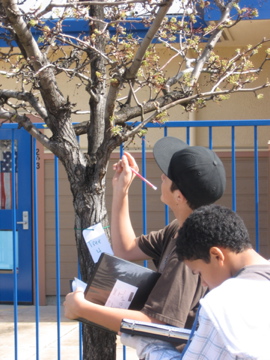The study of seasonal changes in nature is known as phenology. Animals migrate or hibernate for winter. Plants and trees have leaves that bud, open, green up, green down, and finally fall off. We associate these differences as as harbingers of changing seasons. Recently, however, the timing for some species is off.
Latitude influences a location's temperature and amount daily sunshine. The closer one is to the equator, the warmer the temperatures and more consistent the daily sunshine. 
Differences in temperature and amount light prompt plants to bloom. As average temperatures in areas warm, bloom time changes for some plants. My students and I observe this on our campus in Livermore.
Ornamental cherry trees are found throughout our campus. When I first started working at Christensen Middle School nine years ago, all of the trees were in full bloom at once, in mid March. I remember this well because many students were miserable with allergies because of the flowers. Students coughed and sneezed. Eyes were red, watering, and itchy. Tissues were used by the boxful. Each year since then I've watched the trees, wanting to be prepared for the students' complaints.
Year by year since then, the trees blossomed earlier and out of sync. Some trees now flower in January. This year, the majority of trees flowered in February. One tree has had leaves continuously for the past 16 months, and, last year, blossomed twice within twelve months. Why this happens is a puzzle. Perhaps a reader can suggest some probable causes. The stress of continuing to produce energy year long has caused this tree to be shorter and have a narrower trunk than the trees near it.
Students enjoy tracking the trees, and are quick to remind me when an observation is needed. We follow GLOBE phenology protocol (see globe.gov) and use the GLOBE Plant Color Guide (available online for purchase) to track and quantify leaf color. Students improve observation and critical thinking skills with this activity. Students also get a chance to get outside and think about the world around them. Good questions are posed, leading to further studies.
Project Bud Burst (http://budburst.org) anyone to contribute to their research by getting outside, observing local plants, and documenting observations on the bud burst web site. Even entering a single observation helps this global citizen science project learn about our changing world. Teachers may receive free online training to learn how to use plant observation activities with students.
You may search the PolarTREC site for lessons use phenology data, and descriptions of seasonal observations in teachers' journal posts. Also, please check out my TED-Ed video on phenology at . I'll see you outside!


Comments